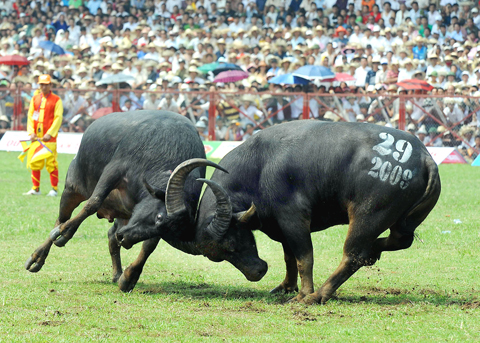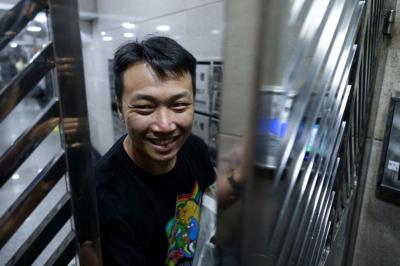With his big dark eyes, cuddly girth and gentle manner, he does not look like a fighter. Except for his horns. Curved like a scythe, they could inflict serious damage. He is known only as buffalo No. 18, one of 16 specially trained beasts that made it through to the finals of an annual northern Vietnam buffalo fighting contest that took place recently.
Do Son’s buffalo-fighting tradition dates back centuries, organizers say, but its modern form has become a big-money event with high-priced sponsorship, high-stakes gambling and thousands of dollars in prize money.
For the participants, though, it is most importantly about community pride in this coastal district of fishermen and farmers near the northeastern port city of Haiphong.

PHOTO: AFP
“I trained this buffalo like a sports athlete,” Luong Duy Hong, 59, says the day before the fight.
Hong, a nephew of the buffalo’s owner, likens the animal to a professional soccer team with a big following of fans.
“It’s the pride of the whole club. This is Manchester,” he says, walking the buffalo in the late afternoon sun.
Buffalo can still be seen laboring in Vietnam’s fields but No. 18 and other fighters are different. Like professional athletes, they are scouted and bought with one thing in mind: to compete.
“I sent my nephews to try to find a proper buffalo,” says its owner, Luong Trac Ty, 75.
After months of searching they settled on this one, which has no name and is known only by the number printed in white on its dark rump.
The farming family bought it in February for 60 million dong (US$3,400) and spent another 40 million of their own money on training and upkeep, they said.
That is a large sum in a country whose per capita income is about US$1,000.
Tradition says Ty’s buffalo is brave because its thin hair is twirled into small spiral formations above each shoulder and on each side of its rump.
“That’s one of the reasons we chose this one,” he says.
Bravery is one thing, but a fighting buffalo also needs training.
Gesticulating and talking excitedly, Hong says he has spent two hours every day swimming in a river and running with the buffalo, which has made it through two preliminary rounds to reach the finals.
After spending so much time with each other, man and buffalo have become close — “like brothers,” Hong says.
But this is their last day together because, win or lose, every buffalo is slaughtered and its meat sold outside the stadium to people who believe it will bring them luck.
“When he is killed, I will not be there,” Hong says.
Owners can recoup some of their expenses from the meat, which sells at a premium, while winning the fight would earn them a 40 million dong prize.
But Hong says buffalo fighting is not a business: “We participate for our honor and for the tradition of our area.”
The next morning, haze turns the newly risen sun into an orange disc before seven teams, each from a district in the Do Son area, parade to the stadium. In traditional dress they hold altars aloft, carry Buddhist flags and bang drums with their buffalo following behind.
Several thousand people have filled the stadium to overflowing. Ty smiles and says his buffalo is ready.
The fights are between two buffalo at a time. Sometimes there is a dramatic charge, a cracking sound as horns smash together, and pushing to and fro like wrestlers in a sumo match.
“It’s like a martial art,” says Nguyen Van Hung, 29, a spectator from Haiphong.
“I feel sorry when I see the blood on their faces,” says Nguyen Quynh Huong, 28, who nonetheless cheers throughout.
The crowd shouts at the violent butting of heads but is far more restrained than the area’s notorious soccer fans.
At times there is little for them to get excited about; the animals simply stand there ignoring each other. As soon as one of the beasts turns tail and begins heading toward the exit, he loses.
After the months of preparation, Ty’s buffalo gets its chance. It briefly touches horns with its opponent, which then gives a short chase. No. 18 trots off, a loser.
The final bout finishes just as quickly.
A buffalo owned by Hoang Gia Bon that beat three challengers earlier in the morning rushes toward its last opponent, hooking into its horns and lifting its head high. In about 60 seconds it is over.
“This buffalo was born with the nature to win,” Bon says.
The wet-nosed animal’s young handlers — among them Bon’s son Vu Duc Minh — crowd around it shouting in victory.
As a handler, 17-year-old Minh was on the edge of the field during the fight.
“I was very scared, not for myself but for the buffalo because he is the pride of the whole extended family and we invested so much energy in him,” he says.
His sadness that the animal will be killed is somewhat tempered by knowledge that its meat will be offered to their ancestors and to the community’s patron saint.
Local legend attributes the festival’s origin to the 18th century, when two buffalo about to be sacrificed for the patron saint suddenly began fighting.

Four people jailed in the landmark Hong Kong national security trial of "47 democrats" accused of conspiracy to commit subversion were freed today after more than four years behind bars, the second group to be released in a month. Among those freed was long-time political and LGBTQ activist Jimmy Sham (岑子杰), who also led one of Hong Kong’s largest pro-democracy groups, the Civil Human Rights Front, which disbanded in 2021. "Let me spend some time with my family," Sham said after arriving at his home in the Kowloon district of Jordan. "I don’t know how to plan ahead because, to me, it feels

The collapse of the Swiss Birch glacier serves as a chilling warning of the escalating dangers faced by communities worldwide living under the shadow of fragile ice, particularly in Asia, experts said. Footage of the collapse on Wednesday showed a huge cloud of ice and rubble hurtling down the mountainside into the hamlet of Blatten. Swiss Development Cooperation disaster risk reduction adviser Ali Neumann said that while the role of climate change in the case of Blatten “still needs to be investigated,” the wider impacts were clear on the cryosphere — the part of the world covered by frozen water. “Climate change and

Poland is set to hold a presidential runoff election today between two candidates offering starkly different visions for the country’s future. The winner would succeed Polish President Andrzej Duda, a conservative who is finishing his second and final term. The outcome would determine whether Poland embraces a nationalist populist trajectory or pivots more fully toward liberal, pro-European policies. An exit poll by Ipsos would be released when polls close today at 9pm local time, with a margin of error of plus or minus 2 percentage points. Final results are expected tomorrow. Whoever wins can be expected to either help or hinder the

DENIAL: Musk said that the ‘New York Times was lying their ass off,’ after it reported he used so much drugs that he developed bladder problems Elon Musk on Saturday denied a report that he used ketamine and other drugs extensively last year on the US presidential campaign trail. The New York Times on Friday reported that the billionaire adviser to US President Donald Trump used so much ketamine, a powerful anesthetic, that he developed bladder problems. The newspaper said the world’s richest person also took ecstasy and mushrooms, and traveled with a pill box last year, adding that it was not known whether Musk also took drugs while heading the so-called US Department of Government Efficiency (DOGE) after Trump took power in January. In a